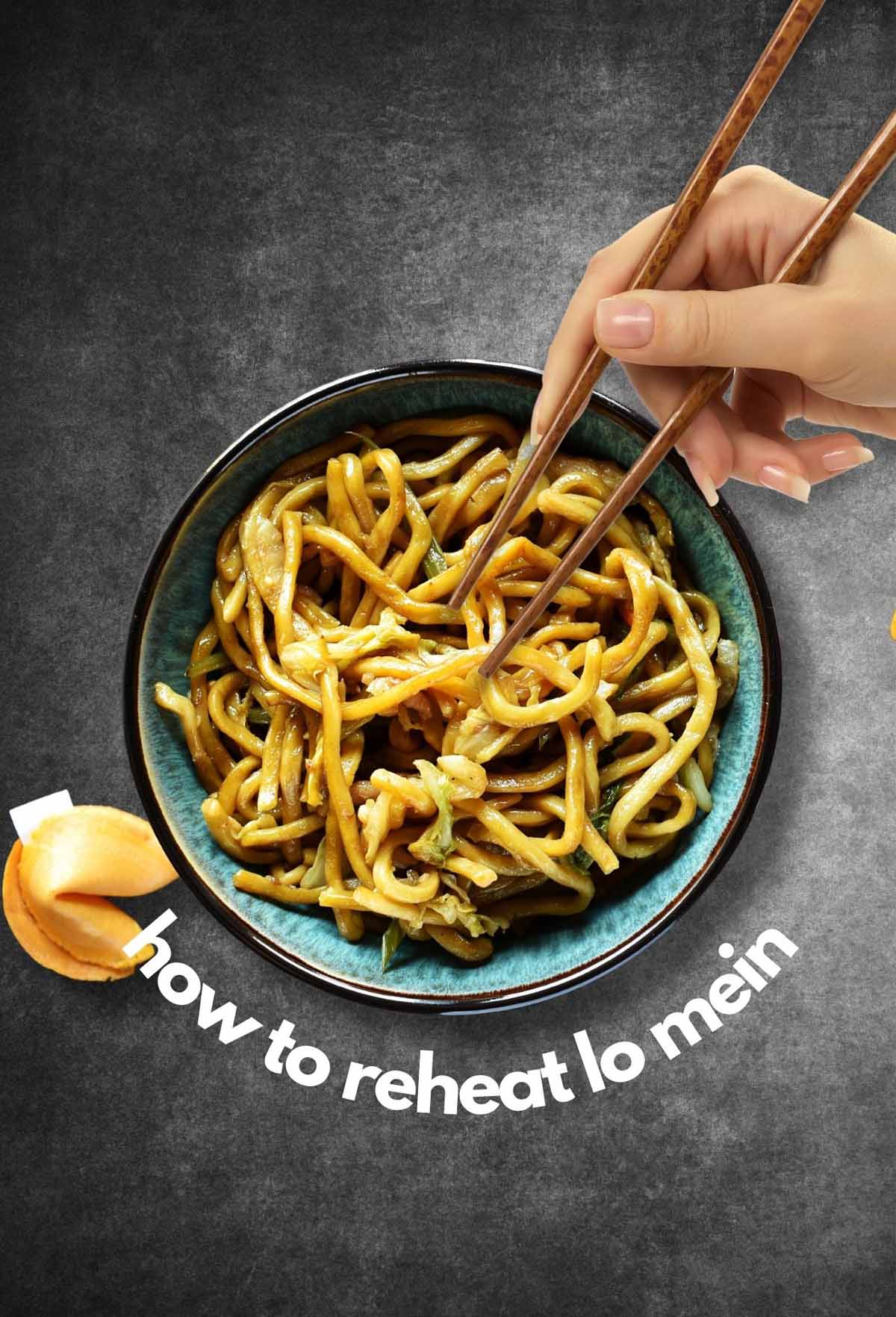Learning how to reheat Lo Mein properly can turn your leftovers from "meh" to "magnificent" in just a few simple steps. The tricky part is preserving the flavors and keeping the noodles from becoming mushy. I've been experimenting in my kitchen for years and can guide you on making your Lo Mein taste just as good the second time. We'll cover everything from the stovetop, the microwave, and the oven.
Take aways:
- Gentle Handling: Manage your Lo Mein leftovers with care to keep the noodles' texture intact during reheating.
- Hydrate Sensibly: Sprinkle some water on your Lo Mein before reheating; it generates steam that refreshes the noodles without sogginess.
- Boost the Flavor: Reinforce the dulled flavors of your Lo Mein with a touch of soy sauce, white pepper, or sesame oil.
- Fresh Crunch Addition: Add fresh veggies during reheating to restore the satisfying crunch and enrich the meal's appeal.

How to Reheat Lo Mein: in 3 Ways
1 Stovetop Method
Let's start with the stovetop, a fantastic option that gives you control and yields deliciously refreshed Lo Mein.
Bring out the pan. Use a non-stick pan large enough to accommodate your Lo Mein without crowding. Overcrowding steams the noodles instead of reheating, leading to a mushy texture.
Medium heat, please. Set your stove to medium heat. Too high, and you risk drying out your noodles; too low, and they might end up soggy.
Add a dash of oil. A little oil can go a long way in preventing your noodles from sticking and enhancing their flavor. Canola or vegetable oil works great.
In go the noodles. Spread your Lo Mein evenly across the pan and let them heat for a minute.
Stir it up. Toss the noodles every minute or so to ensure even reheating. If you spot any stubborn cold spots, break them up with your spatula.
The finishing touch. After about 5 minutes, your Lo Mein should be hot and ready to eat. Before you take it off the stove, give it a quick taste. If needed, you can add some soy sauce or sesame oil to refresh the flavors.

2 The Microwave Method:
If you're pressed for time, the microwave can be a lifesaver. Here's how to get the best out of it.
Microwave-safe dish. Transfer your Lo Mein to a microwave-safe dish. A shallow dish is preferable as it promotes even heating.
A touch of water. Drizzle a tiny bit of water over the noodles—just enough to create some steam during the heating process.
Cover it up. To keep the moisture in, loosely cover the dish with a microwave-safe lid or plastic wrap.
Heat in bursts. Start with 1-minute intervals at full power, stirring between each interval for even heat distribution.
Serve hot. Once the Lo Mein is heated thoroughly, let it sit for a minute before digging in.

3 Reheating Lo Mein in the Oven:
The oven isn't the conventional choice for Lo Mein, but it can be useful if you're dealing with a larger quantity. Here's how to do it.
Preheat the oven. Preheat your oven to 300°F (150°C).
Choose your dish. Use an oven-safe dish that can comfortably hold your Lo Mein.
Add moisture. Like with the microwave method, add a small amount of water to the dish to create steam in the oven.
Cover with foil. Seal the dish with aluminum foil to lock in the moisture and promote even reheating.
Bake. Put the dish in the pre-heated oven and bake for about 15 to 20 minutes. Halfway through, give the Lo Mein a good stir.
Ready to serve. Once the Lo Mein is heated thoroughly, remove it from the oven and let it cool for a couple of minutes before serving.
Remember, every reheating method comes with its own pros and cons. It's all about finding the one that suits you best for the most delicious Lo Mein leftovers!
Tips When Reheating Lo Mein
Drawing on decades of culinary experience, we have some tricks to turn reheating into a mini gourmet session.
- Be gentle with your leftovers: When storing your Lo Mein, handle them with care to prevent breaking the noodles. This helps maintain texture during reheating.
- Rehydrate the right way: A sprinkle of water can work wonders when reheating Lo Mein, especially in the microwave or oven. It helps generate steam that rehydrates the noodles without making them soggy.
- Refresh with seasoning: Over time, your Lo Mein flavors may dull. Don't shy away from a splash of soy sauce, a sprinkle of white pepper, or a drizzle of sesame oil.
- Add fresh veggies: If your Lo Mein had veggies, they might wilt or lose their crunch in the fridge. Consider adding some fresh ones during the reheating process to bring back that satisfying crunch.
- Heat evenly: Ensuring your Lo Mein heats evenly is key no matter the reheating method. Stir regularly and break up any noodle clusters for the best results.
Common Mistakes in Reheating
Reheating Lo Mein is pretty straightforward, but it's not immune to common kitchen mishaps. Let's highlight a few and how to avoid them.
- Avoid the soggy noodle trap: Too much water can ruin the texture of your Lo Mein, leaving you with soggy noodles. Be sparing with your water addition, if needed at all.
- No to high heat: High heat can dry out your noodles or make them chewy. Whether you're using a stovetop, oven, or microwave, remember - patience is a virtue.
- Steer clear of rubbery veggies: If your Lo Mein has vegetables, too much heat can make them rubbery. Consider adding them towards the end of the reheating process or swap them with fresh ones.
- Say no to flavor loss: The flavor can sometimes dull down in leftovers. Don't hesitate to perk up your Lo Mein with some additional seasoning.
- Escape the uneven heating pitfall: Cold spots are common when reheating food. Break up noodle clusters and stir your Lo Mein regularly for evenly distributed heat.
With these tips and tricks in mind, you're all set to master the art of reheating Lo Mein and enjoy your leftovers in all their glory!
Reheating Lo Mein: Flavor is King
When we think about Lo Mein, we might find our minds wandering off to a delightful dish bursting with taste, color, and texture. We savor every mouthful when preparing it, but what about the leftovers? Have you ever noticed a dip in taste and texture when you reheat Lo Mein the next day? It's all too common, but it doesn't have to be.
Reheating Lo Mein, A Game-Changer for Your Palate
Let's set the scene. Picture yourself after a long day with no energy to cook. Your gaze lands on a container of Lo Mein sitting in your fridge. It's tempting. But past experiences of reheating this delectable dish have resulted in dry noodles or an off-balance of flavors, and you hesitate. It doesn't have to be this way. With the right knowledge, we can keep our Lo Mein as rich and full of flavor as when it first hit the wok. Let's delve deeper into the how and why of it.
The Many Facets of Asian Cuisine
Cooking Asian cuisine, especially dishes like Lo Mein, is as much an art as it is a science. Each ingredient, from the soy sauce to the ginger to the array of veggies, contributes to the harmony of the final product. The method of cooking and even the order in which the ingredients hit the pan all play a role in the complexity and depth of flavor.
Reheating these dishes requires the same level of attention and detail like playing a symphony where every instrument contributes to the overall harmony. Even reheating can be a chance to develop the flavors further if done correctly. So, are you ready to bring your Lo Mein back to life? Let's begin.
Inside the World of Lo Mein
Why Lo Mein Stands Out
Lo Mein! The mention of it might bring back memories of family dinners or your favorite takeout spot. But what is it about this dish that makes us keep coming back for more? It's the alchemy of simple yet flavorful ingredients.
We start with wheat flour noodles, known for their distinct chewy texture. Then, we have a delightful mix of vegetables, usually cabbage, carrots, and bean sprouts. We often add a protein—chicken, beef, shrimp, or tofu.
But the real magic happens when we introduce the sauce—a symphony of soy sauce, oyster sauce, sesame oil, sugar, and sometimes a touch of chicken broth. This sauce ties everything together, glazing the noodles and seeping into every nook and cranny. Each mouthful bursts with umami goodness, balanced by the subtle sweetness and the refreshing crunch of the veggies. That's Lo Mein for you—comfort in a bowl.
Reheating: A Make-or-Break Moment for Your Lo Mein
We all love the idea of leftovers, don't we? But let's face it: reheating can be tricky, especially with a dish as delicate as Lo Mein. Each element in this dish—the noodles, the veggies, the protein, and the sauce—responds differently to heat.
Overdo it, and you could end up with mushy noodles, limp vegetables, and a sauce that's lost its vibrant flavor. But underdo it, and you'll be left with a lukewarm, unappetizing mess. So, what do we do? How do we tread this thin line?
The answer lies in understanding the dish and applying the right reheating technique. We'll dive into this in the upcoming sections, so stick around, and let's learn how to master the art of reheating Lo Mein together.
Gearing Up for Reheating Success
Must-Have Tools for Reheating Lo Mein
Now, let's talk about the gear. To perfectly reheat Lo Mein, you won't need a fancy setup. But you do need to be mindful about what tools you're using. Each tool can give a different result, and choosing the right one can make a big difference.
- The stovetop and a non-stick pan: If you ask me, this is the top choice for reheating Lo Mein. It gives you control over the heat and allows for even reheating. And with a lid on top, you can trap in the steam, keeping your noodles moist and flavorful.
- The microwave: Quick and convenient, the microwave can come in handy when you're in a rush. But remember to use a microwave-safe dish and keep an eye on the timer!
- The oven: Not my first recommendation for Lo Mein, but it can do the trick if you handle it right. A low heat setting and some foil to lock in moisture could give you decently reheated Lo Mein.
Pros and Cons
Each of these tools has its merits and drawbacks.
- The stovetop lets you recreate the stir-fry process, refreshing the flavors and textures. But it does require you to be attentive and perhaps do a bit of stir-and-toss action.
- The microwave, on the other hand, is all about speed and convenience. But be warned—microwaves can unevenly heat your food and might make your noodles a bit rubbery if you're not careful.
- And the oven, well, it's a bit of a wild card. It can be an option if you don't want to stand by the stove and don't mind the longer reheating time. But ovens can easily dry out your food, so you must take measures to retain that precious moisture.
Homemade Lo Mein Recipe
You know, there's nothing quite like a hearty plate of homemade Lo Mein. It's a beloved Asian classic that stands tall in its own right, even when compared to other favorites in the cuisine, like Pad Thai. If you've ever found yourself pondering the nuances between Pad Thai vs Lo Mein, I encourage you to give my crafted Lo Mein recipe a spin. With its fantastic blend of flavors, textures, and a dash of home-cooked love, it's an absolute delight. So, go ahead, embark on this culinary journey.
How to Store Lo Mein Properly
Storage tips to extend the life of your Lo Mein
Storing your Lo Mein properly can make a difference when it's time for the next round. Let's dive into some helpful storage hacks.
- Cool before you store: Before you tuck your Lo Mein away in the fridge, let it cool down to room temperature. This helps prevent moisture build-up, which can lead to sogginess or spoilage.
- Tight is right: Use airtight containers to store your Lo Mein. They help retain the flavors and prevent the noodles from drying out.
- Freezer for the long haul: If you don't plan to eat your Lo Mein within 3-4 days, the freezer is your friend. Just make sure you pack it in freezer-safe containers or heavy-duty freezer bags.
- Individual portions: Consider storing your Lo Mein in individual portions. This makes reheating only what you need easier, avoiding multiple thawing and reheating cycles.
How to tell if your Lo Mein is still good to eat
Even with the best storage practices, Lo Mein can't last forever. Here's how to tell if it's still good to eat.
- Trust your nose: This is your first line of defense. If your Lo Mein smells off or unpleasant, it's best to throw it out.
- Examine the texture: Fresh Lo Mein should feel slightly sticky but not slimy. If it feels slimy or unusually sticky, it's probably spoiled.
- Look for mold: Any visible mold is a definite sign of spoilage. If you see mold, it's time to toss the Lo Mein.
- Taste test: If your Lo Mein passes the smell and look test, you can taste a small piece. If the taste seems off, it's best not to eat it.
Remember, it's always better to be safe than sorry. If you're in doubt about the freshness of your Lo Mein, it's best to err on the side of caution and not eat it. The joys of a tasty Lo Mein dish are not worth the risks of food poisoning.
Frequently Asked Questions
How can you effectively reheat Lo Mein without drying it out?
A: The secret lies in adding a touch of water before reheating. Whether you're using the microwave, stove, or oven, sprinkle some water over your Lo Mein. This creates steam during reheating, preventing the noodles from drying out. Remember, don't go overboard; a splash is all you need.
What are the best methods to reheat Lo Mein in the microwave?
A: Place your Lo Mein in a microwave-safe dish and sprinkle some water over it. Cover the dish loosely with a microwave-safe lid or another dish. Microwave for one minute, then stir the noodles. Repeat this process until your Lo Mein is evenly heated.
How long should you reheat Lo Mein on the stovetop?
A: Reheating Lo Mein on the stovetop usually takes about 5-7 minutes. Heat a skillet over medium heat, add a splash of oil and your Lo Mein. Stir frequently to ensure even heating.
Are there any secret tips for storing and reheating Lo Mein?
A: Storing your Lo Mein in individual portions can be a game-changer. This way, you only reheat what you need, and the rest stays fresh in the fridge or freezer. When reheating, remember to add a touch of water to keep your Lo Mein moist.
Can you reheat Lo Mein in the oven? How?
A: Absolutely! Preheat your oven to 350°F (175°C). Place your Lo Mein in an oven-safe dish, sprinkle with water, and cover with aluminum foil. Bake for about 20 minutes, stirring halfway to ensure even heating.
What signs should you look for to know if your Lo Mein is still good to eat?
A: Use your senses. If your Lo Mein smells off, looks moldy, feels slimy, or tastes odd, it's best to discard it.
How can you prevent your Lo Mein from becoming soggy when reheating?
A: The key is not to overheat it. Whether using a microwave, stovetop, or oven, heat your Lo Mein just enough to warm it through. Overheating can make your noodles soggy.
How does the process of reheating affect the texture and flavor of Lo Mein?
A: If done right, reheating can enhance Lo Mein's flavor as the ingredients have more time to meld. However, over-reheating or not adding enough moisture can affect the texture, making your noodles either too dry or too soggy.
What common mistakes should you avoid when reheating Lo Mein?
A: Avoid reheating your Lo Mein too many times, as it can make your noodles mushy and ruin the flavors. Also, remember to cool your Lo Mein before refrigerating, and always use an airtight container for storage.
How does proper storage impact the reheating process of Lo Mein?
A: Proper storage preserves the flavor and texture of your Lo Mein. It also helps the noodles reheat more evenly. Always store your Lo Mein in an airtight container and reheat only the amount you plan to eat.




